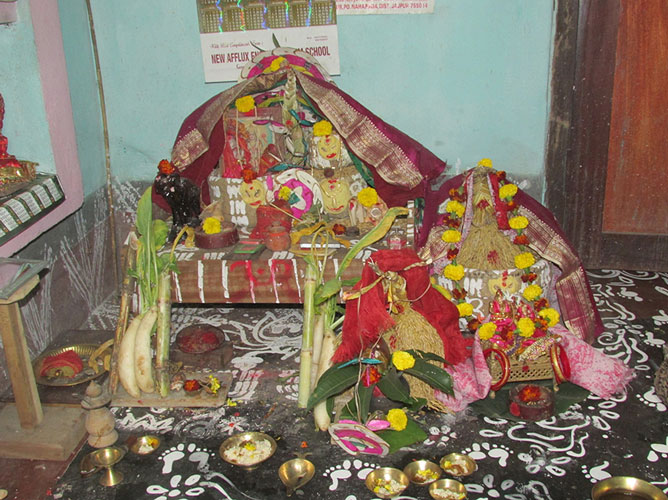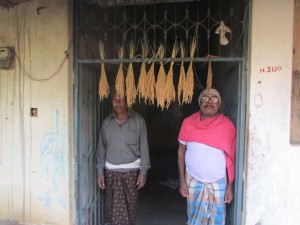
Mana filled with freshly harvested Swarna-Sub1. (Photo: Debdutt Behura)
Swarna-Sub1 is the flood-tolerant version of the popular mega-variety Swarna (MTU 7029) in eastern India. It was developed by scientists from the International Rice Research Institute (IRRI), evaluated and released in India by Central Rice research Institute (CRRI), and disseminated by IRRI in collaboration with the national agricultural research systems, government organizations, nongovernment organizations, and public and private seed companies in India. In the eastern state of Odisha, where Swarna occupies more than 30% of the total rice area, both the state and central government are distributing Swarna-Sub1 seeds through various schemes such as the National Food Security Mission and Bringing Green Revolution to Eastern India (BGREI).
Swarna-Sub1 is almost identical to its counterpart Swarna in terms of grain yield and grain quality, but it has an added advantage—it can survive full submergence for more than 2 weeks. However, the husk color of Swarna-Sub1 is much lighter than that of Swarna, which is reddish. Because of this difference, the farmers in Odisha call Swarna “Nali Swarna” (Red Swarna) and Swarna-Sub1 “Dhala Swarna” (White Swarna).
Farmers’ feedback

Braided Swarna-Sub1 paddy is hung in front of the house to bring prosperity. (Photo: Debdutt Behura)
In October 2013, during our visit to Jajpur District, a stronghold of Swarna, which is grown on 65% of the total rice area, we made several stops throughout the day and talked with farmers about the performance of Swarna-Sub1. Our visit took place 2 days before the state was expected to be pounded by cyclone Phailin, one of the most powerful tropical storms ever to make landfall in India.
Most of the feedback from farmers on Swarna-Sub1 was quite positive. There were a few complaints regarding seed shattering of Swarna- Sub1 during harvest and transportation. But, most of the farmers who grew Swarna-Sub1 for the first time in 2012 on parts of their land have expanded it to their entire landholding.
In Amathpur Village, located between two rivers, the Birupa and Brahmani, we also came across a large patch of land of about 80 hectares, which was mostly planted with Swarna-Sub1. Normally before, this area was left fallow because of frequent flooding during the kharif season. Then, the farmers would plant the area with mungbean once the floodwater receded.
We were told that that was the first time many farmers planted rice in the area because they were able to get access to flood-tolerant Swarna-Sub1 through the BGREI seed distribution program. Coincidently, the area was flooded for 6 to 8 days due to heavy rainfall that preceded the cyclone and, as expected, Swarna-Sub1 recovered quite well from the flood.
In the late afternoon, we visited a few nonflood-prone villages in Binjharpur block where a nonprofit organization had distributed Swarna-Sub1 seeds in the 2012 wet season. Surprisingly, even in areas that are not prone to flooding, many farmers had a favorable opinion about Swarna-Sub1. Swarna-Sub1 has been adopted by some farmers in the second season because of its resistance to diseases, particularly to sheath blight. However, many other farmers have decided to grow Swarna-Sub1 on parts of their land because of its lighter husk color, which is preferred for offerings to their deities during religious rites.
Margasira masa (month in Oriya), which normally falls in mid- November to mid-December, is one of the auspicious months that coincides with the paddy harvest, threshing, and storage. Every Thursday of this month, known as the Manabasa Gurubar, freshly harvested paddy is filled in a mana (a pot made out of bamboo cane used for measuring paddy in the old days) and is placed at the center of a circular chita to worship the goddess Lakshmi.
Chita is the traditional Oriya art form in which walls and floors are decorated with murals using semiliquid rice paste. The drawings could be small footmarks of Lakshmi, a stack of paddy, flowers, peacocks, and elephants, among other designs. The married women in every household clean and decorate the floor, wall, entrances, and grain storage structure with chita. The new paddy harvest is also braided and hung in front of the house, near a pooja altar (a special place in the room used during worship and also kept near the mana).
We went back to Jajpur District in December, the last Manabasa Gurubar of 2013, to witness the use of new Swarna-Sub1 paddy during this holy month. After visiting around 15 villages in Binjharpur block, we knew already that Swarna-Sub1 is widely accepted by the community forManabasa Gurubar and for other religious uses.
The future of Swarna-Sub1

The entrance of a house decorated with chita. (Photo: Debdutt Behura)
Swarna-Sub1 outyields Swarna and other popular varieties under submerged conditions. This makes Swarna ideal for flood-prone rice areas in the state. Apart from replacing Swarna and other popular nonflood-tolerant varieties, it can make perennially flooded areas flourish with rice. Before, these areas were normally left fallow during the kharif season, just like what has happened in Amathpur Village. Lastly, Swarna-Sub1 may not be just limited to flood-prone rice areas. It could potentially take a slice of nonflood-prone rice areas because it is becoming more acceptable for cultural and religious uses.
_________________________________________
Note: Thanks to Drs. Achim Dobermann, Umesh Singh, Abdel Ismail, and Takashi Yamano for some excellent suggestions.
_________________________________________
Dr. Mohanty is the head of the Social Sciences Division and program leader (Targetting and policy) at IRRI. Dr. Behura is an assistant professor at the Orissa University of Agriculture and Technology.








For cultivation